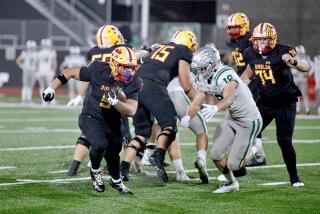Prep Kickers Take Aim at a Moving Target : Football: Some games are on college fields, with goal posts 18 feet 6 inches wide. Others are on high school fields, with 23-feet 4-inch posts.
John Stonehouse, Loyola High’s touted placekicker, took great interest in his team’s 1991 schedule when he found out last May that the NCAA was going to implement its decision to narrow the goal posts in college football by nearly five feet.
Stonehouse wanted to make sure the Cubs did not have any games on college fields. Because Loyola does not have its own stadium, it shares other Southland sites for home games, often at community colleges.
“I breathed a big sigh of relief when I didn’t see any college fields on the schedule,” said Stonehouse, whose older brother, Paul, played at Loyola and is now the punter at Stanford. “Five feet is a very big difference for a placekicker. It is especially tough when kicking at angles. You have to remember that the hash marks have not changed.”
College uprights are 18 feet 6 inches apart this year, but the width of the goal posts on high school fields remains 23 feet 4 inches.
Although Stonehouse, a senior, is spared having to kick between college uprights this year, he has altered his workouts in hopes of improving his chances of receiving a Division I scholarship.
In practice last season, Stonehouse would aim field goal tries and point-after-touchdown attempts for the center of the goal posts. Now he aims for one post to enhance accuracy.
Other prep kickers also have altered their practice routines. Buddy Wellman, a highly regarded senior at Redlands High, follows a procedure similar to that of Stonehouse.
Wellman had little choice, however, because Redlands plays its home games at the University of Redlands. The college put in new goal posts during the summer and made no alternate plans for wider uprights.
“The school called us to discuss the situation,” said Dave Perkins, coach at Redlands High. “Because of the cost factor, there wasn’t much they could do. I told them we understand, and I really haven’t had any complaints. My kicker has performed just as well as last year. Of course, if I didn’t have such a talented kicker, I might have more concerns.”
In a home game against Quartz Hill recently, Wellman connected on field goals of 46 and 38 yards and barely missed on a 51-yard attempt.
Yucaipa High also plays home games at the University of Redlands, and Coach Jim Taylor said he had his kickers change their workouts early last summer.
“We don’t have goal posts on our practice field, so we assembled some practice posts and just put them at the narrower distance,” Taylor said. “(In a recent game), our guy went four for four in PATs, so it hasn’t been a big problem for us so far.”
Opponents are not quite as happy about the situation. In Yucaipa’s home opener, Moreno Valley kicker Roger Mesa was not his usual reliable self. Although Moreno Valley won, 16-13, Mesa missed a conversion attempt and a field goal try. Coach Chuck Ball said a review of the game film showed that the missed kicks would have been good if the uprights had been of high school width.
“We didn’t tell Roger that the goal posts were narrower,” Ball said, “but he kept saying something seemed strange. At our game the next week, he said he noticed a world of difference. Although I didn’t get upset about the issue against Yucaipa, I might have been singing a different tune if we had lost because of one of those missed kicks.”
Because many football fields in the Southland and across the nation are shared by college and high school teams, the National Federation of State High School Athletic Assns. said high school teams would have to abide by the narrower uprights. Federation officials said they have no plans to follow the NCAA and change the width of the uprights on high school fields.
Although the conflict is affecting a small number of teams this season, the problem will escalate in the next few years as more community colleges make the changeover.
Community college teams try to abide by NCAA rules, but they make switches more slowly when they are costly.
Owen Hahn, coach at Santa Monica College and president of the California Community College Football Coaches Assn., said he expects all of the state’s community college fields to have the narrower goal posts by 1993.
There are alternatives for high school teams playing on college fields. At the University of Northern Iowa’s UNI-dome, the school has installed retractable goal posts that can be widened or narrowed in a matter of minutes.
“We had a welder put an expandable sleeve on the horizontal crossbar, and we had predrilled holes in specific positions,” said Jim Egli, assistant athletic director for facilities at Northern Iowa. “The process was easy and not too expensive. The high school coaches were grateful.”
Bill Clark, CIF Southern Section administrator in charge of football, said he has not given the goal post predicament much thought, but admits he will have to spend a lot of time this spring coordinating with community colleges that share fields with high schools.
“This can end up being a big problem, or it can be a minor one if we work things out with all parties,” he said. “I’m sure solutions can be found. Otherwise, conflicts are bound to increase.”
More to Read
Go beyond the scoreboard
Get the latest on L.A.'s teams in the daily Sports Report newsletter.
You may occasionally receive promotional content from the Los Angeles Times.










